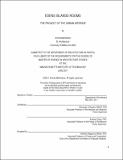| dc.contributor.advisor | Alexander D'Hooghe and Arindam Dutta. | en_US |
| dc.contributor.author | Mahindroo, Amrita | en_US |
| dc.contributor.other | Massachusetts Institute of Technology. Dept. of Architecture. | en_US |
| dc.coverage.spatial | a-ii--- | en_US |
| dc.date.accessioned | 2011-09-13T17:45:47Z | |
| dc.date.available | 2011-09-13T17:45:47Z | |
| dc.date.copyright | 2011 | en_US |
| dc.date.issued | 2011 | en_US |
| dc.identifier.uri | http://hdl.handle.net/1721.1/65742 | |
| dc.description | Thesis (S.M.)--Massachusetts Institute of Technology, Dept. of Architecture, 2011. | en_US |
| dc.description | Cataloged from PDF version of thesis. | en_US |
| dc.description | Includes bibliographical references (p. 138-141). | en_US |
| dc.description.abstract | The privately owned public interior, defined here as an enclosed urban space owned by a private entity, has been a recurrent character of many 20th century liberal cities. It has today found an epitome in the mega-structural urban enclaves of the developing world. The thesis seeks to challenge the idea of future within these forms. Developed as technologically deterministic, aesthetic totalities for a precise public in their present, they do little to anticipate the potential publics they may have to absorb as and when the fleeting conditions, which necessitate these forms have subsided into history. Herein, they reveal the comic tragedy of instating architecture with the design of the city, that most desired scope of work. The city, which by its liberal democratic definition is a creator of possibility, is thus reduced to a handful of variables in light of architecture's hegemony, and points once again to a recurrent disciplinary malaise for death by total design. This totality comes all too clearly at the expense of excluding a generous swath of a present and future public and the potential it offers. Whilst the radical manifesto has become a thing of the past, the best means of contemporary attack is elective participation. By this I mean to acknowledge one's constraints within the market, and to deliberate over the potential agency of architecture through more operative means. Herein, a self-conscious sense of humor about the discipline's megalomania is paired with the sincere ideals for creating urban possibilities through architectural form within the structure of neo-liberal economics. This coupling is explored through the design of an enclave for financial services in Mumbai, India. As the breadth of what constitutes the Indian middle class encroaches monumentality, the possibilities for an inclusive, privately owned public interior are interrogated through a manifesto for its ideal spatial tool, the room. A product of both architecture and urbanism, the room mediates between both disciplines by standing as a definitive form through its enclavic walls and simultaneously creating urban possibility in its void. | en_US |
| dc.description.statementofresponsibility | by Amrita Mahindroo. | en_US |
| dc.format.extent | 141 p. | en_US |
| dc.language.iso | eng | en_US |
| dc.publisher | Massachusetts Institute of Technology | en_US |
| dc.rights | M.I.T. theses are protected by
copyright. They may be viewed from this source for any purpose, but
reproduction or distribution in any format is prohibited without written
permission. See provided URL for inquiries about permission. | en_US |
| dc.rights.uri | http://dspace.mit.edu/handle/1721.1/7582 | en_US |
| dc.subject | Architecture. | en_US |
| dc.title | Edens islands rooms : the project of the urban interior | en_US |
| dc.title.alternative | Project of the urban interior | en_US |
| dc.type | Thesis | en_US |
| dc.description.degree | S.M. | en_US |
| dc.contributor.department | Massachusetts Institute of Technology. Department of Architecture | |
| dc.identifier.oclc | 748853447 | en_US |
